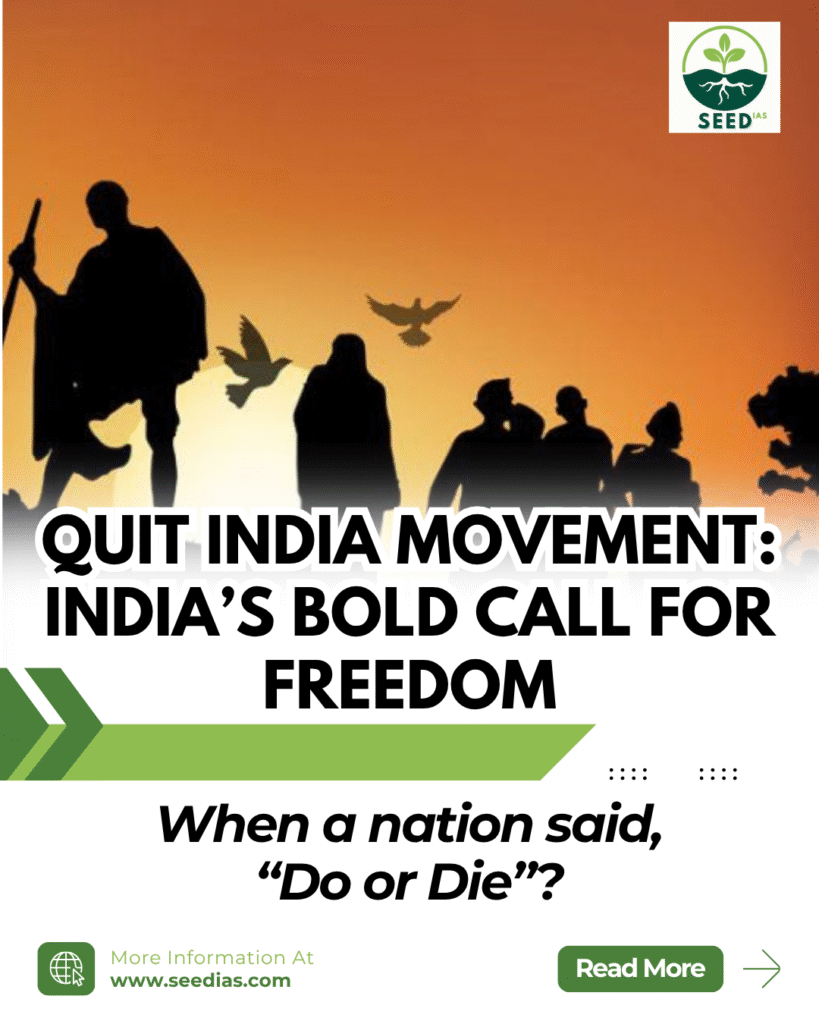Why in NEWS
India celebrates 8th August every year as Quit India Movement Day (August Kranti Diwas) to commemorate the historic movement of 1942 that demanded the immediate end of British rule.
Key Terms / Concepts
| Term / Concept | Explanation |
|---|---|
| Quit India Movement (QIM) | A mass uprising launched on 8th August 1942 by Mahatma Gandhi demanding the immediate end of British rule in India. |
| August Kranti Maidan | Formerly Gowalia Tank Maidan in Bombay, where Gandhi gave his “Do or Die” speech. |
| “Do or Die” | Gandhi’s powerful call to either achieve independence or perish in the struggle. |
| Cripps Mission | British mission in March 1942 offering dominion status after WWII, rejected by Congress. |
| Yusuf Meherally | Socialist leader who coined the slogan “Quit India” and earlier “Simon Go Back.” |
| Parallel Governments | Local self-rule bodies formed during QIM in places like Ballia, Tamluk, and Satara. |
Key Details
| Aspect | Details |
|---|---|
| Launch & Purpose | Started on 8th August 1942 at Bombay session of AICC after Cripps Mission failure. Gandhi gave “Do or Die” call. |
| Symbolism & Leadership | Aruna Asaf Ali hoisted the national flag; leaders like Lohia, JP Narayan emerged; women like Matangini Hazra and Sucheta Kripalani played key roles. |
| Nature | Mass uprising different from earlier movements; while rooted in non-violence, allowed self-defense and sabotage of British property. |
| Muslim League’s Role | Stayed away, viewing QIM as Hindu-dominated, deepening communal divides. |
| Events Leading to QIM | WWII without consultation, Cripps Mission failure, economic hardships, Bengal famine (1943), Japanese invasion of Burma, rise of INA under Subhas Bose. |
Outcomes of the Movement
| Outcome | Explanation |
|---|---|
| British Repression | Mass arrests, suppression, collapse of British authority in some areas. |
| Parallel Governments | Local self-rule established in Ballia, Tamluk, and Satara. |
| Unity | Strengthened resolve for independence across classes and regions. |
| Political Divisions | Muslim League’s absence widened Congress-League gap. |
| Path to Independence | Movement weakened British control, paving way for 1947 independence. |
In a Nutshell
Mnemonic to remember: “QIM-1942”
Q – Quit India call
I – Immediate independence demand
M – Mass uprising with women & youth leaders
1 – “Do or Die” speech
9 – 1942 year
4 – Four major causes (WWII, Cripps failure, famine, INA rise)
2 – Two key outcomes (unity + British weakening)
Prelims Questions
- Which leader coined the slogan “Quit India”?
a) Mahatma Gandhi
b) Yusuf Meherally
c) Subhas Chandra Bose
d) Aruna Asaf Ali - Which place was formerly known as Gowalia Tank Maidan?
a) August Kranti Maidan
b) Jallianwala Bagh
c) Rajghat
d) Teen Murti Bhavan - Parallel Government during the Quit India Movement was NOT established in:
a) Ballia
b) Tamluk
c) Satara
d) Champaran
Mains Questions
- Discuss the significance of the Quit India Movement as the final mass struggle against British rule in India. 10 Marks
- “The Quit India Movement was both a unifying and a divisive moment in India’s freedom struggle.” Critically examine. 15 Marks
Prelims Answers & Explanations
| Q No. | Answer | Explanation |
|---|---|---|
| 1 | b | Yusuf Meherally coined “Quit India” and “Simon Go Back.” |
| 2 | a | Gowalia Tank Maidan is now August Kranti Maidan in Mumbai. |
| 3 | d | No parallel government was set up in Champaran during QIM. |
















